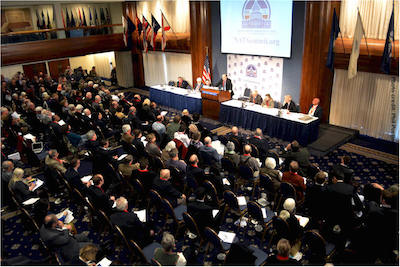26 Billion Bucks: The Jewish Charity Industry Uncovered
Mar 24 2014 / 12:17 am
Part I — Donors Give More to Israel Than to Education
By Josh Nathan-Kazis.
Jewish Daily Forward – The American Jewish community’s network of charity organizations is a font of Jewish power, a source of communal pride and a huge mystery.
We know that the network exists. We know that its federations, social service groups and advocacy organizations influence America’s domestic and foreign policy, care for the old, educate the young and send more than a billion dollars a year to Israel.
Yet until now we’ve had no idea what the network looks like.
Individual organizations file tax returns. Some umbrella groups offer information on their members’ work. But no one has measured the network as a whole: how much it spends, how much it raises, how it prioritizes causes, how much it gets from the government.
Now, the Forward has identified and reviewed tax documents filed by more than 3,600 Jewish organizations in the most comprehensive survey ever of the financial workings of this Jewish tax-exempt ecosystem. And the results are striking.
(Please see the original article for interactive databases)
The American Jewish community’s network of charity organizations is a font of Jewish power, a source of communal pride and a huge mystery.
We know that the network exists. We know that its federations, social service groups and advocacy organizations influence America’s domestic and foreign policy, care for the old, educate the young and send more than a billion dollars a year to Israel.
Yet until now we’ve had no idea what the network looks like.
Individual organizations file tax returns. Some umbrella groups offer information on their members’ work. But no one has measured the network as a whole: how much it spends, how much it raises, how it prioritizes causes, how much it gets from the government.
Now, the Forward has identified and reviewed tax documents filed by more than 3,600 Jewish organizations in the most comprehensive survey ever of the financial workings of this Jewish tax-exempt ecosystem. And the results are striking.
Cash for Israel
The largest share of donor dollars ends up with organizations that focus on Israel.
Of the $3.7 billion in donations that the functional agencies of the communal apparatus receive in a year, 38% goes to Israel-focused groups. That’s more than any other category, including education, which gets just 20% of donations.
Education groups’ cut drops to 16% if Brandeis and Yeshiva universities are excluded from the count. The remaining groups, mostly Hillels, day schools and summer camps that focus primarily on Jewish, rather than secular, education, receive $617 million in donations per year — $807 million less than Israel-focused groups.
“It is quite striking that donor contributions to Jewish education… appear to be quite small, relative to other sectors,” said Theodore Sasson, senior research scientist at the Cohen Center for Modern Jewish Studies and the Steinhardt Social Research Institute, at Brandeis.
The high proportion going to Israel-related groups, Sasson said, is “further evidence… that American Jews are deeply interested in Israel even as they take a variety of different positions with regard to contentious political issues.”
The 619 Israel-focused organizations include advocacy agencies, like the American Israel Public Affairs Committee; groups that send money to Israel, like American Friends of The Hebrew University, and hybrids, like Hadassah, the Women’s Zionist Organization of America.
American Jews give other money to Jewish institutions that isn’t reflected in this breakdown: dues and donations to synagogues, tuition fees to Jewish day schools. But the $3.7 billion represents the philanthropic discretionary spending of American Jews, the money that they choose to give after their obligations to synagogues and other fees are met.
Health care and social service groups receive 20% of this pot, while culture and community groups get 12% and education groups get 20%.
The tilt toward Israel-related causes is also reflected in the grants that the network makes overseas.
All told, Jewish groups make $1.9 billion a year in grants overseas. Charities no longer need to report the specific destination of their overseas grants, so it’s impossible to say what proportion of these dollars went to Israel. Still, half the overseas grants come from Israel-focused organizations, and it’s fair to assume that a significant proportion of the money granted overseas by communal fundraising groups goes to Israel, as well.
Those overseas grants make up 15% of the total program expenses of the network. The Jewish communal fundraising groups, meanwhile, report spending 25% of their total program expenses on overseas grants.
Money in New York
The financial center of the Jewish communal network is located firmly and disproportionately in New York. New York State is home to just a quarter of America’s Jewish population, but $7.2 billion of the $14.6 billion in annual revenues reported by the network go to organizations based there.
The second-largest state by revenue is California, with just $1.2 billion a year, while Massachusetts comes in third, with $930 million. The network is totally absent from Wyoming, Montana, Idaho and North Dakota.
Groups located in Chicago have net assets of $1.6 billion, more than any city but New York City. San Francisco comes in third, with $1.1 billion, followed by Waltham, Mass., where Brandeis University is located.
Most of the largest organizations in the network by any measure are located in New York City.
Yeshiva University spends the most in a year of any Jewish group, followed by the Conference on Jewish Material Claims Against Germany, which distributes funds from the German government to Jewish individuals and charities. Other top spenders include Brandeis, the New York-based American Jewish Joint Distribution Committee and Beth Abraham Health Services, a Bronx-based health care organization that is a network agency of UJA-Federation of New York.
The Rest of the Iceberg
There’s still a lot missing from the sketch of the Jewish not-for-profit network offered by the Forward’s new analysis. If the 3,600 Jewish organizations that filed with the IRS are a snowy iceberg, the Jewish groups that claim a religious exemption and don’t file are the mountain hiding underwater.
The IRS doesn’t require synagogues to file tax returns. Synagogue umbrella groups aren’t required to file either, nor are elementary or high schools that are affiliated with a synagogue. Most rabbinical seminaries qualify as an “integrated auxiliary” of a synagogue or group of synagogues, meaning that they don’t file either.
It’s impossible to say how many such Jewish groups there are, or how much money they raise and spend. In 2010, a University of Washington professor named Paul Burstein published an analysis of a different IRS database that counted 3,495 Jewish religious organizations.
Burstein’s findings suggest that the total number of organizations in the Jewish network may actually be more than twice the number of those that file tax returns. Some of those religious groups may be small congregations with tiny budgets. But others are large: The Jewish Theological Seminary, which is affiliated with the Conservative movement, has a busy campus on the Upper West Side of Manhattan. The Reform movement’s Hebrew Union College-Jewish Institute of Religion has three campuses in the United States and one in Israel.
The $12 billion to $14 billion in annual revenue, the Forward’s best estimate based on tax filings, is probably billions of dollars short of the network’s actual size.
Comparisons Difficult
It’s difficult, if not impossible, to compare the Jewish communal network with networks of charities built by other ethnic and religious groups.
In his 2010 paper, Burstein wrote that no one had conducted a comprehensive review of the charities surrounding any American religious or ethnic group. This appears to continue to be the case. Compounding the problem is that other religious and ethnic groups don’t organize their charities in the same way that the Jewish community does.
Mainline Protestant denominations, for example, conduct their charitable work through their denominational organizations, which in turn receive much of their revenue from their member churches. All these entities claim religious exemptions from the IRS’s filing requirements, so their financial data are opaque. Evangelical Protestant denominations do have large networks of affiliated nonreligious charitable groups. But no estimates appear to exist of the size of the network of these so-called para-church organizations.
What we can say is that the Jewish organizations make up a tiny fraction of the total not-for-profit sphere. All told, the groups that filed Form 990s and Form 990-EZs in 2012 reported receiving $365 billion in contributions, gifts, grants and dues after duplicate filings were excluded. Jewish groups reported getting $7.5 billion — roughly 2% of the total.
Which, fittingly, is roughly the Jewish percentage of the U.S. population.
—–
Contact Josh Nathan-Kazis at nathankazis@forward.com or on Twitter @Joshnathankazis




